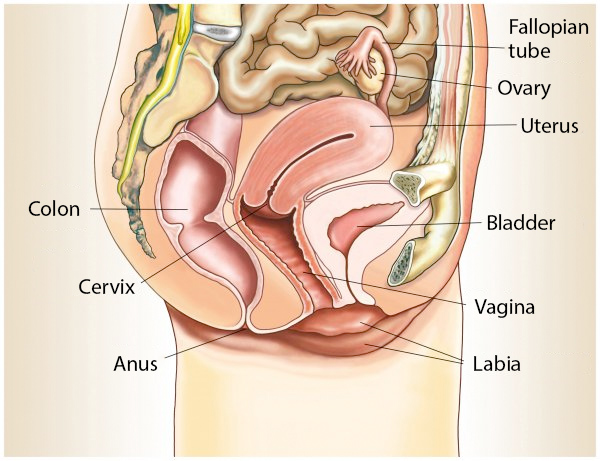Pelvic Organ Prolapse

Physiological Prerequisites and Causes of Prolapse Symptoms
The bladder, bowel and uterus are attached to the bony structure of the pelvis by ligaments and muscles. The pelvic floor plays a particularly important role in this. It ensures that the organs are held in place. As a muscular network, it extends between
- Pubic bone
- Ischial tuberosities
- Coccyx.
There are various factors that cause pelvic organ prolapse and the associated prolapse symptoms. For example, increased pressure from the organs on the muscles of the pelvic floor can result in them no longer being able to do their job to the full extent - during pregnancy or childbirth, for example. Heavy physical exertion due to heavy lifting or sport, genetically determined loose connective tissue, severe coughing, multiple births, obesity and hormonal changes after the menopause can also cause prolapse symptoms.
Learn More about Pelvic Organ Prolapse and Its Causes
If you are experiencing prolapse symptoms or would like to learn more about the physiological conditions and causes, please schedule a consultation with us. We offer comprehensive information about your individual treatment options. Contact us to learn more about effective therapies and preventive measures.
What Are the Symptoms?
Heavy strain on the pelvic floor can cause vaginal prolapse and uterine prolapse. The urethra and bladder lie directly against the vaginal wall. This is why bladder prolapse can occur. Bowel prolapse can also occur, as the rectum lies against the posterior vaginal wall.
A pelvic organ prolapse often occurs after the menopause, as the connective tissue loses stability due to hormonal changes. Patients with pelvic floor weakness do not always have symptoms, in which case no treatment is necessary. Depending on the severity of the damage, a mild or total prolapse may occur.

Generally, the following symptoms can occur with a pelvic organ prolapse:
- Bladder weakness
- Incontinence
- Pain during sexual intercourse
- Pain when urinating
- Frequent urinary tract infections
- Feeling of pressure in the lower abdomen and vagina
- Constipation
Recognizing Prolapse Symptoms
If symptoms are present, they should be clarified by a doctor at an early stage in order to prevent organ prolapse. Surgery is not always necessary. Existing changes in the position of the organs can be detected by an ultrasound scan of the pelvis. The consequences of a prolapse on the function of the bladder and sphincter are assessed as part of a urodynamic examination.
Avaiable Therapy and Treatment Options
- Conservative Therapy
Conservative treatment at a specialized center is sufficient for mild pelvic organ prolapse. Pelvic floor training uses special exercises to strengthen the muscles of the pelvic floor and can keep the vagina, uterus and bowel in place. Other treatment options include local hormone treatment, stimulation of the bladder and pelvic floor muscles and therapy with special aids such as pessaries or vaginal tampons. Pessaries are rings, shells or cubes made of soft silicone. These can be inserted by the patient herself and prevent unwanted urine leakage. - Surgical Treatment
If the prolapse is very pronounced and conservative treatment does not provide any improvement, surgery is an option. The aim is to restore the normal functioning of the bladder and bowel. The original position of the organs is reconstructed.
The operation is often performed through the vagina. If the anterior or posterior septum is tightened, the bladder or bowel are returned to their physiological position. The uterus can also be attached to the pelvis or removed. If the patient suffers from multiple prolapses, the procedure can be performed via an abdominal incision. In this case, a mesh is attached to the anterior and posterior vaginal wall and fixed to the sacrum.
A minimally invasive and precise prolapse operation of the bladder, uterus or rectum can also be performed robot-assisted via Da Vinci surgery. The Da Vinci sacrocolpopexy involves the use of a robot, with which the surgeon operates from a console to control the arms holding a camera or instruments inside the patient's body. The DaVinci System® is one of the most modern developments in laparoscopic surgical technology.
Further information on surgical treatment options can be found on our page on operations for pelvic organ prolapse (coming soon).

An Unpleasant Topic?
Pelvic organ prolapses and prolapse symptoms are common, but are rarely talked about. Around one in three women over the age of 55 suffers from weak pelvic floor muscles.
Although pelvic floor prolapse and other pelvic organ prolapses can be treated well, it is a shameful taboo subject for many sufferers. Patients often restrict themselves in their everyday lives. They participate less in activities and public life and avoid talking about it. However, it does not have to be that way.
A friendly team of experts is at your disposal at the Hirslanden Continence Center. Gynecologists and urologists know that going to the doctor with vaginal, bladder and uterine complaints is not always easy. We maintain an open and respectful relationship with our patients.
Do You Have Any Concerns or Questions about Pelvic Organ Prolapse?
Prolapse organ prolapses are widespread, but are often not addressed openly. Our friendly team at the Hirslanden Continence Center understands your concerns and offers you a respectful approach. Contact us for a consultation and find out more about your individual treatment options.
